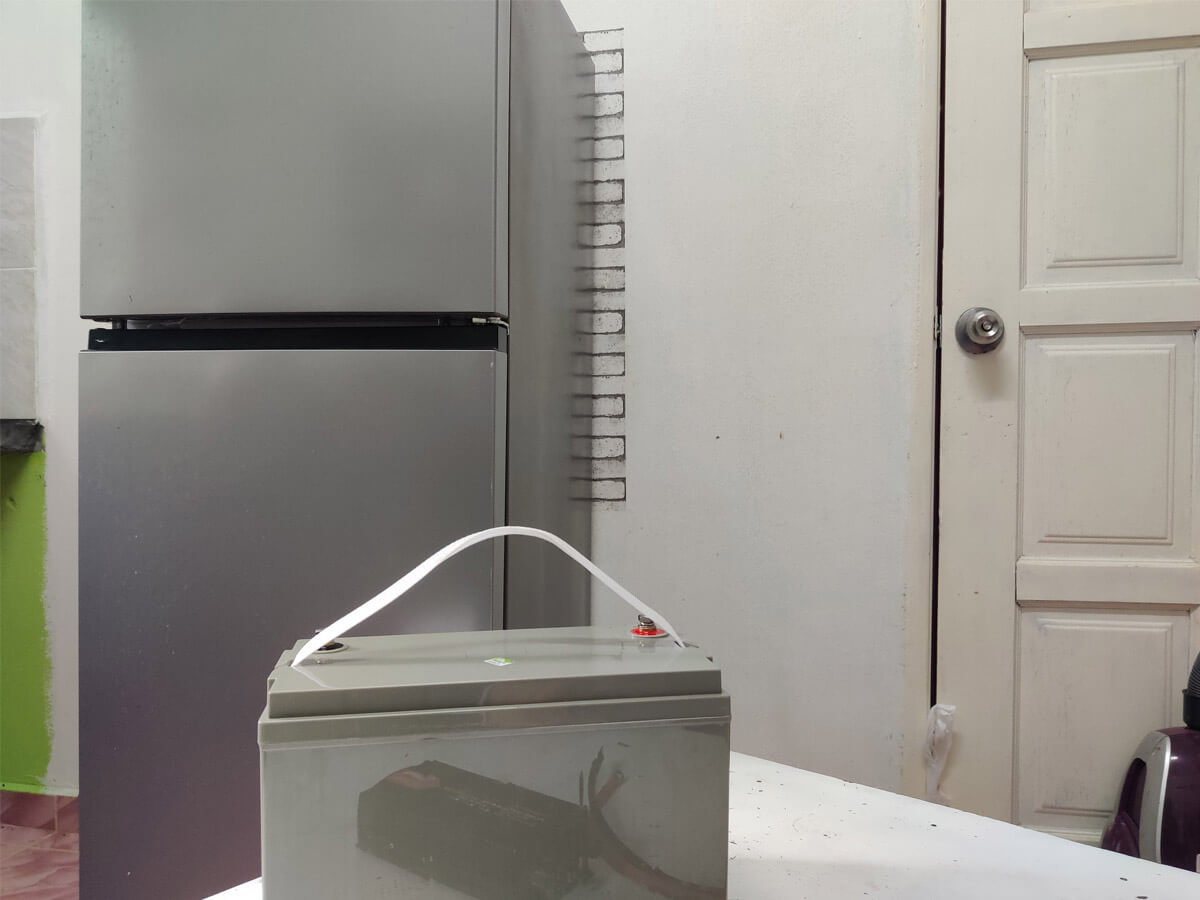 I tested a 12V 100Ah battery to see how long it would power my fridge, and it lasted about 7 hours. However, this result is specific to fridges of similar size or energy usage.
The runtime of a fridge on such a battery depends on two factors:
I tested a 12V 100Ah battery to see how long it would power my fridge, and it lasted about 7 hours. However, this result is specific to fridges of similar size or energy usage.
The runtime of a fridge on such a battery depends on two factors:
- The electricity usage of the fridge: Measured in kWh (kilowatt-hours) or Wh (Watt-hours), the electricity usage of your fridge varies based on factors like size, energy efficiency, room temperature, set temperature, fridge fill level, and door openings.
- The usable capacity of the battery: Aside from the Rated Capacity of your battery (e.g., 1200 Wh), the Usable Capacity of the battery will also depend on its type or chemistry. While Lithium batteries can be fully discharged, Lead-Acid batteries can only supply 50% of their rated capacity before needing a recharge.
| Capacity (Cubic feet, Liters, and Quarts) | Fridge Type | Estimated runtime on a 12V 100Ah battery | |
| Lead-Acid Battery | Lithium Battery | ||
| 1 ft 3 (28 L) (30 QT) | 12V fridge | 45 to 65 hours | 90 to 130 hours |
| 2 ft 3 (56 L) (60 QT) | 12V fridge | 35 to 50 hours | 70 to 100 hours |
| 3.5 ft 3 (100 L) (105 QT) | Mini-fridge | 22 to 40 hours | 45 to 80 hours |
| 4.5 ft 3 (127 L) (135 QT) | Mini-fridge | 18 to 32 hours | 35 to 65 hours |
| 7 ft 3 (200 L) (210 QT) | RV/Residential | 10 to 20 hours | 20 to 40 hours |
| 10 ft 3 (280 L) (300 QT) | RV/Residential | 8 to 15 hours | 16 to 30 hours |
| 14 ft 3 (400 L) (420 QT) | Residential | 6 to 10 hours | 12 to 20 hours |
| 20 ft 3 (560 L) (600 QT) | Residential | 4 to 7 hours | 8 to 15 hours |
| 25 ft 3 (700 L) (750 QT) | Residential | 3 to 6 hours | 6 to 12 hours |
I get commissions for purchases made through links in this post.
Test Video: A 12V 100Ah Lead Acid battery VS. my refrigerator
Here’s a video version of my test. Check it out!Testing how long will a 12V 100Ah battery run a fridge
I wanted to see how long my fridge could run on a battery, so I used a 12V 100Ah Lead-Acid battery for the experiment.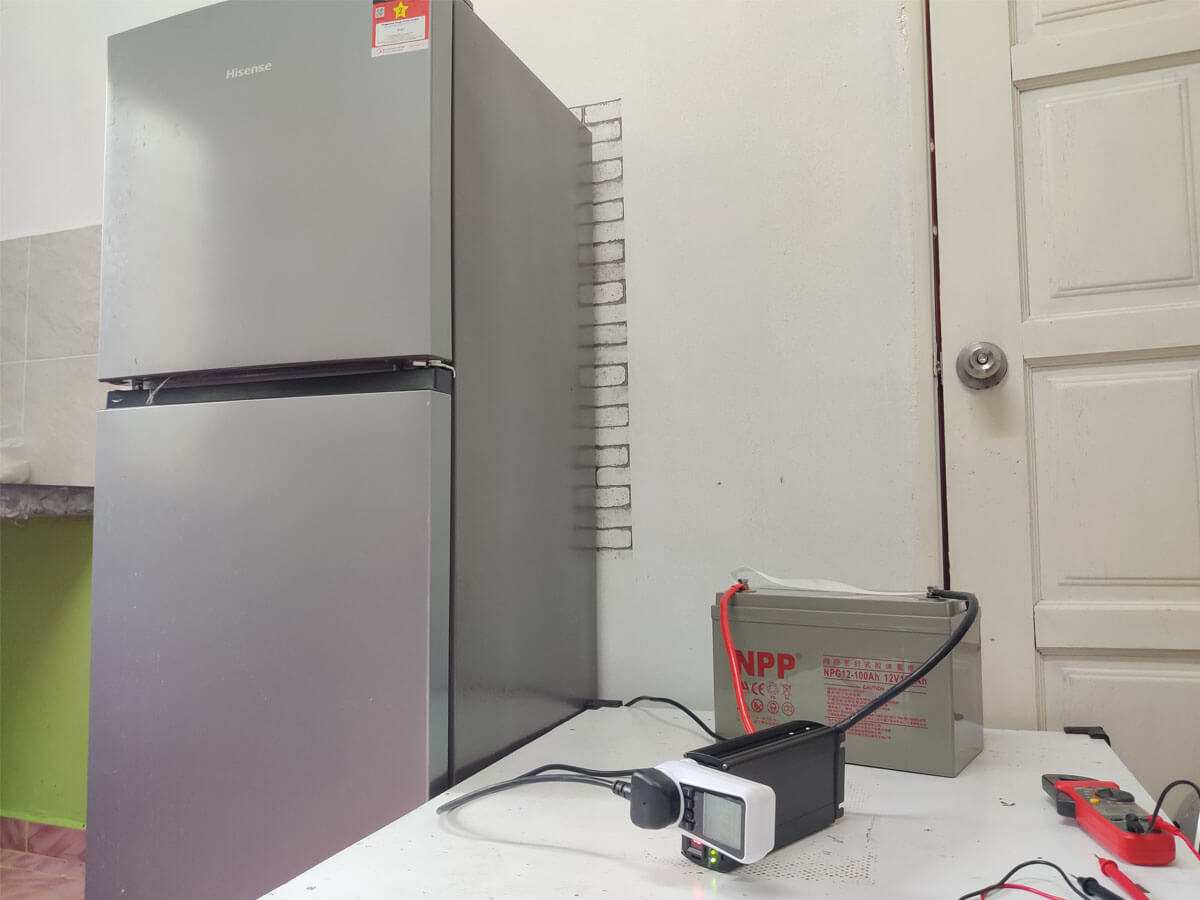 Given that refrigerators like this one operate on AC (Alternating Current) power, and batteries exclusively provide DC (Direct Current) power, I needed to conenct the fridge to the battery using a power inverter.
This particular inverter was a Pure Sine Wave inverter with a Continuous Wattage rating of 500 Watts:
Given that refrigerators like this one operate on AC (Alternating Current) power, and batteries exclusively provide DC (Direct Current) power, I needed to conenct the fridge to the battery using a power inverter.
This particular inverter was a Pure Sine Wave inverter with a Continuous Wattage rating of 500 Watts:
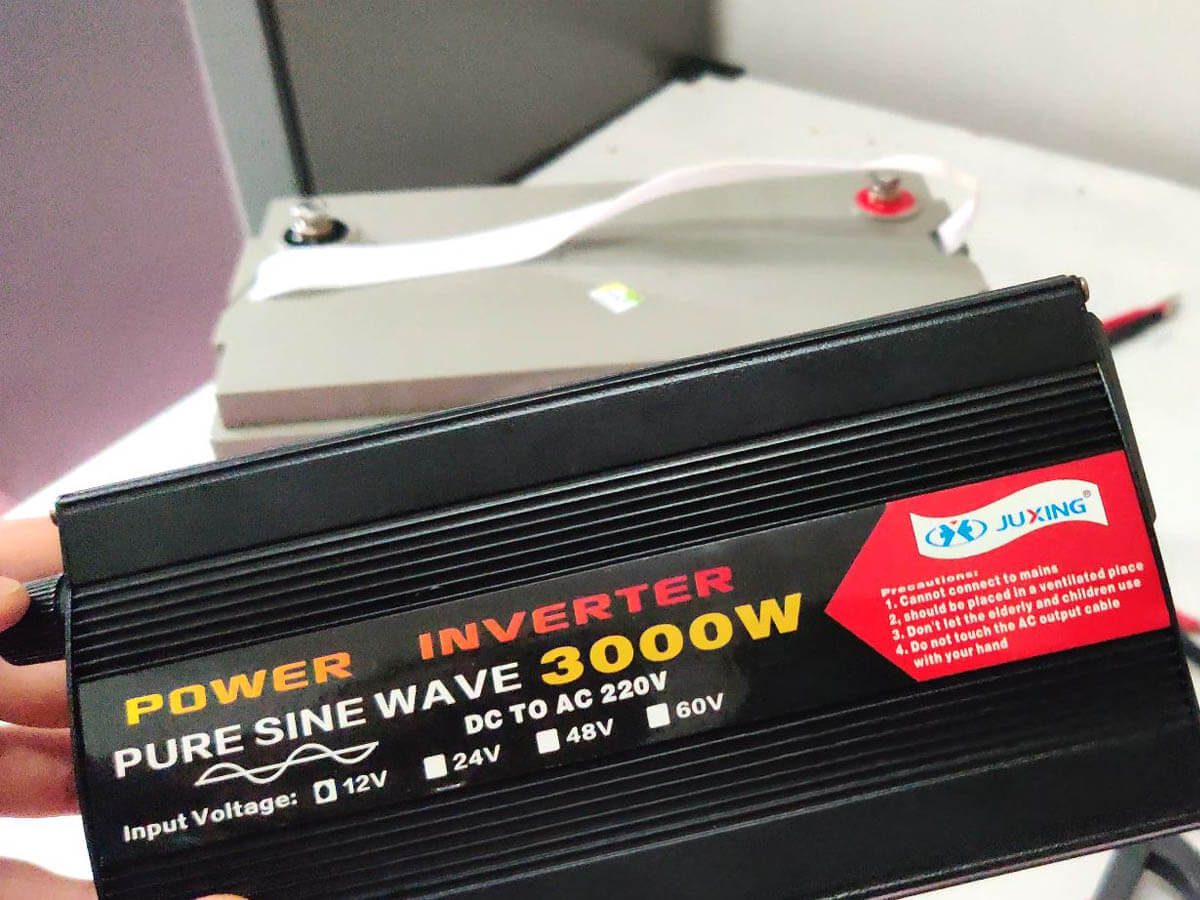 Check out my article on determining what size inverter you need to run your fridge.
To provide more perspective, here are some details about my specific test:
Check out my article on determining what size inverter you need to run your fridge.
To provide more perspective, here are some details about my specific test:
- My refrigerator is mid-sized, approximately 7 Cu. ft. (200L or 210 QT) in capacity, similar to most RV refrigerators.
- The refrigerator was filled to about 80% of its capacity.
- I set the fridge to its maximum cooling setting for the duration of the test.
- Throughout the test, I only opened the refrigerator’s door about once every hour.
- The fridge operated at a room temperature ranging from 86°F to 90°F (30°C to 32°C) on the day of the test.
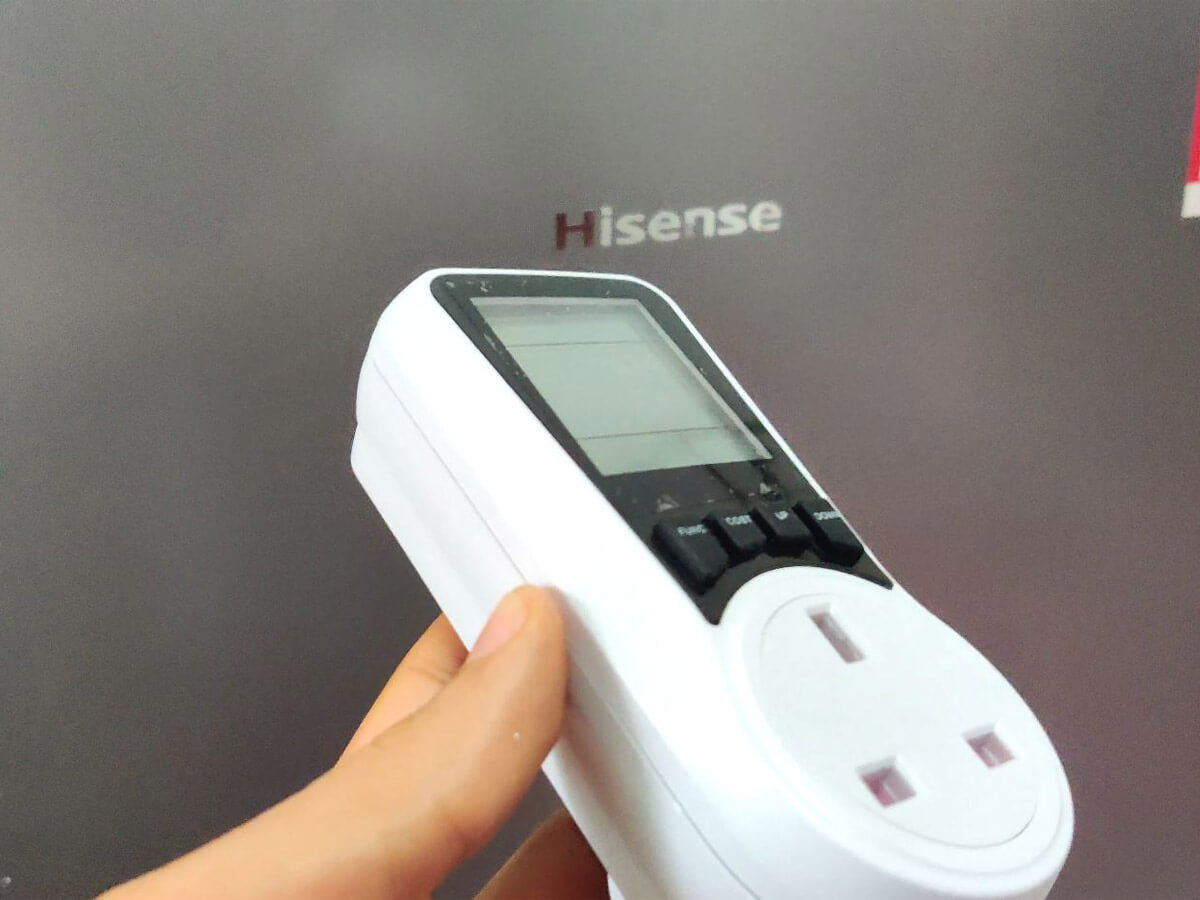
Electricity Usage Monitors
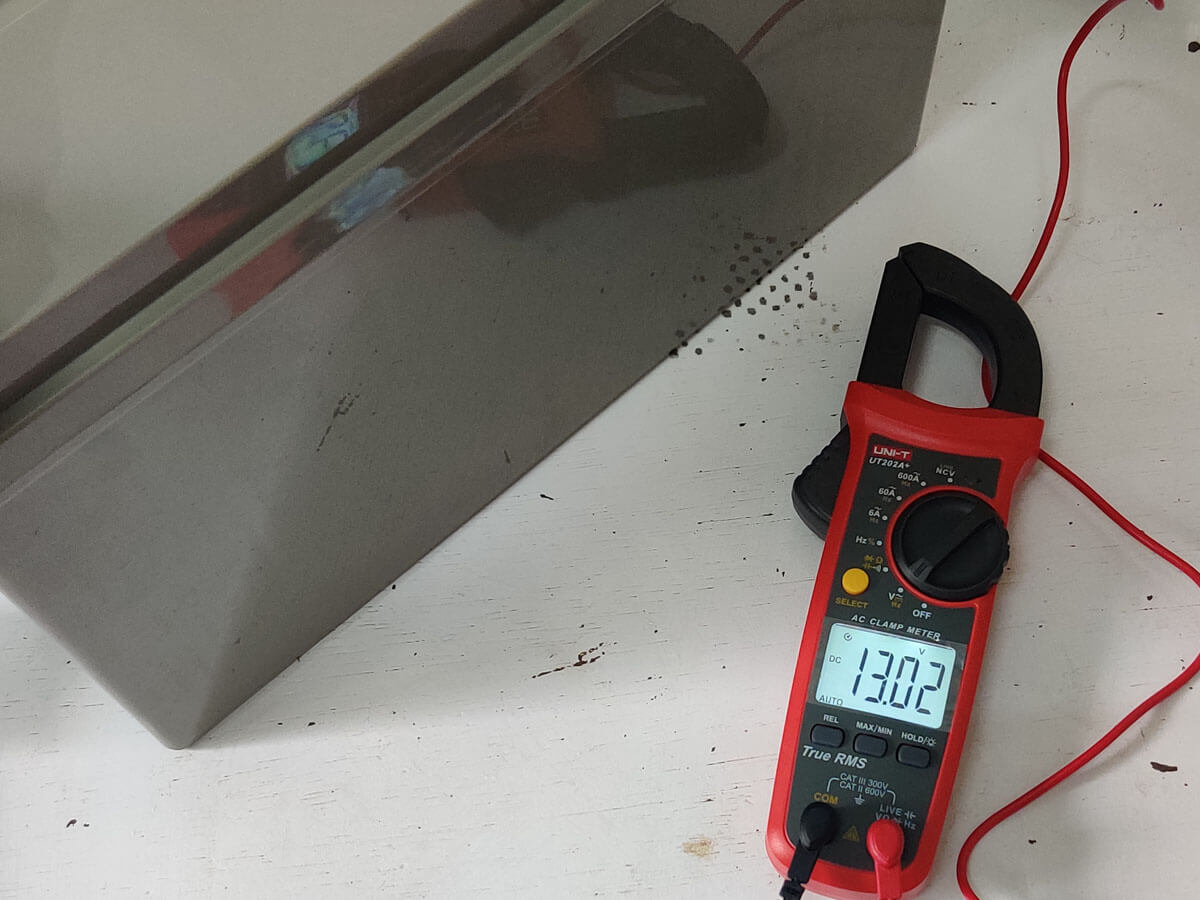 Also, this is a 12V 100 Ah battery, which means it has an energy capacity rating of 1200 Wh (12V x 100Ah). But since it’s a Lead-Acid battery, I can only make use of 50% of that energy capacity (600 Wh) to avoid shortening the battery’s lifespan.
Related: How many watt hours in a 100Ah 12V battery?
To ensure I maintain above a 50% state of charge on the battery, I connected my electricity monitor to the inverter and then plugged the fridge into the monitor to keep an eye on its electricity usage.
Also, this is a 12V 100 Ah battery, which means it has an energy capacity rating of 1200 Wh (12V x 100Ah). But since it’s a Lead-Acid battery, I can only make use of 50% of that energy capacity (600 Wh) to avoid shortening the battery’s lifespan.
Related: How many watt hours in a 100Ah 12V battery?
To ensure I maintain above a 50% state of charge on the battery, I connected my electricity monitor to the inverter and then plugged the fridge into the monitor to keep an eye on its electricity usage.
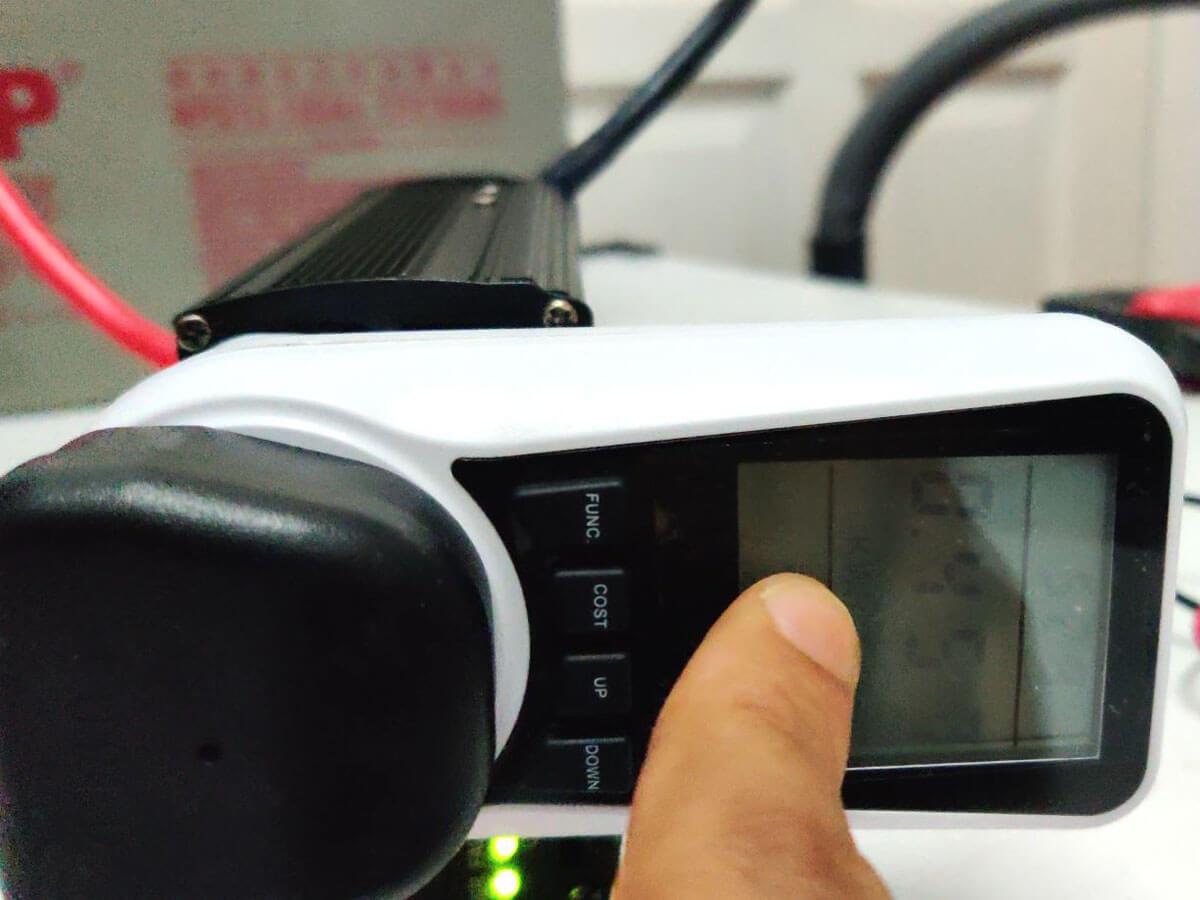
12V-100Ah Lead-Acid Batteries
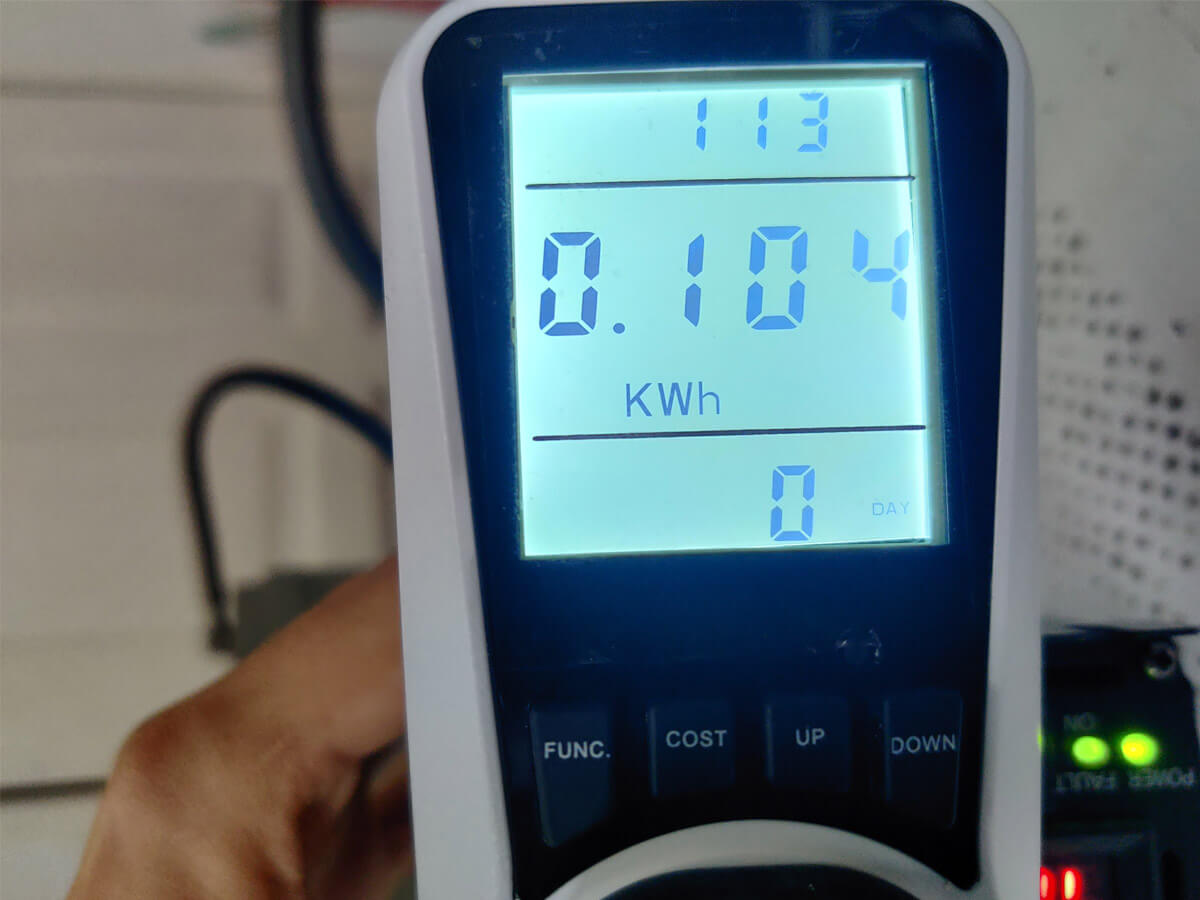 I returned later to check the energy usage again, and after 6 hours and 36 minutes, the fridge had consumed 0.555 kWh (555 Wh) of energy.
I returned later to check the energy usage again, and after 6 hours and 36 minutes, the fridge had consumed 0.555 kWh (555 Wh) of energy.
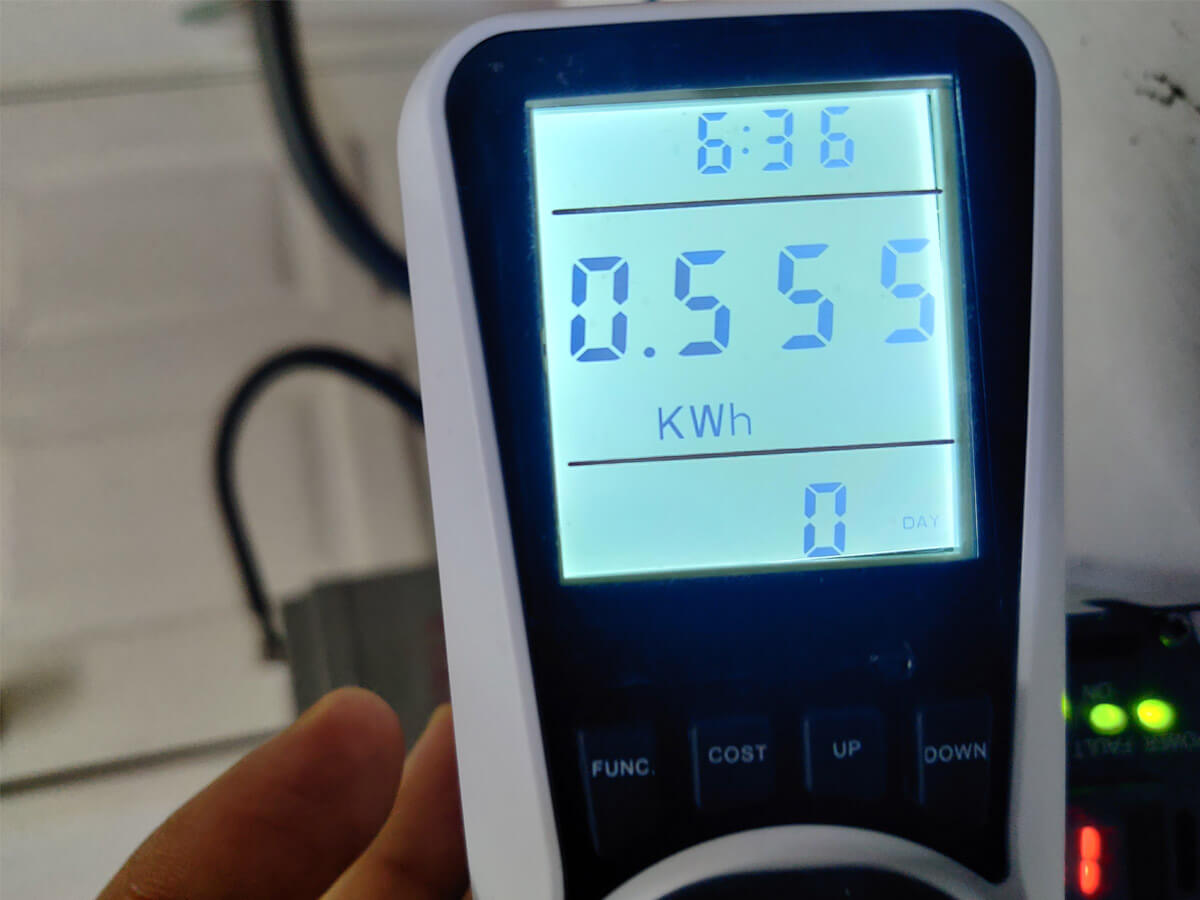 But it’s important to remember that the refrigerator was operating on the battery through an inverter, which, like any device performing electrical conversions (in this case, DC to AC), isn’t 100% efficient.
Based on the documentation of my inverter, it was approximately 90% efficient. This means that the refrigerator would only use 90% of the energy drawn from the battery.
So, despite the refrigerator consuming only 555 Wh of energy, the battery likely supplied more than 600 Wh. To ensure the battery doesn’t drop below 50%, I decided to switch off the inverter and conclude the test.
Here’s the voltage of the battery after the test:
But it’s important to remember that the refrigerator was operating on the battery through an inverter, which, like any device performing electrical conversions (in this case, DC to AC), isn’t 100% efficient.
Based on the documentation of my inverter, it was approximately 90% efficient. This means that the refrigerator would only use 90% of the energy drawn from the battery.
So, despite the refrigerator consuming only 555 Wh of energy, the battery likely supplied more than 600 Wh. To ensure the battery doesn’t drop below 50%, I decided to switch off the inverter and conclude the test.
Here’s the voltage of the battery after the test:
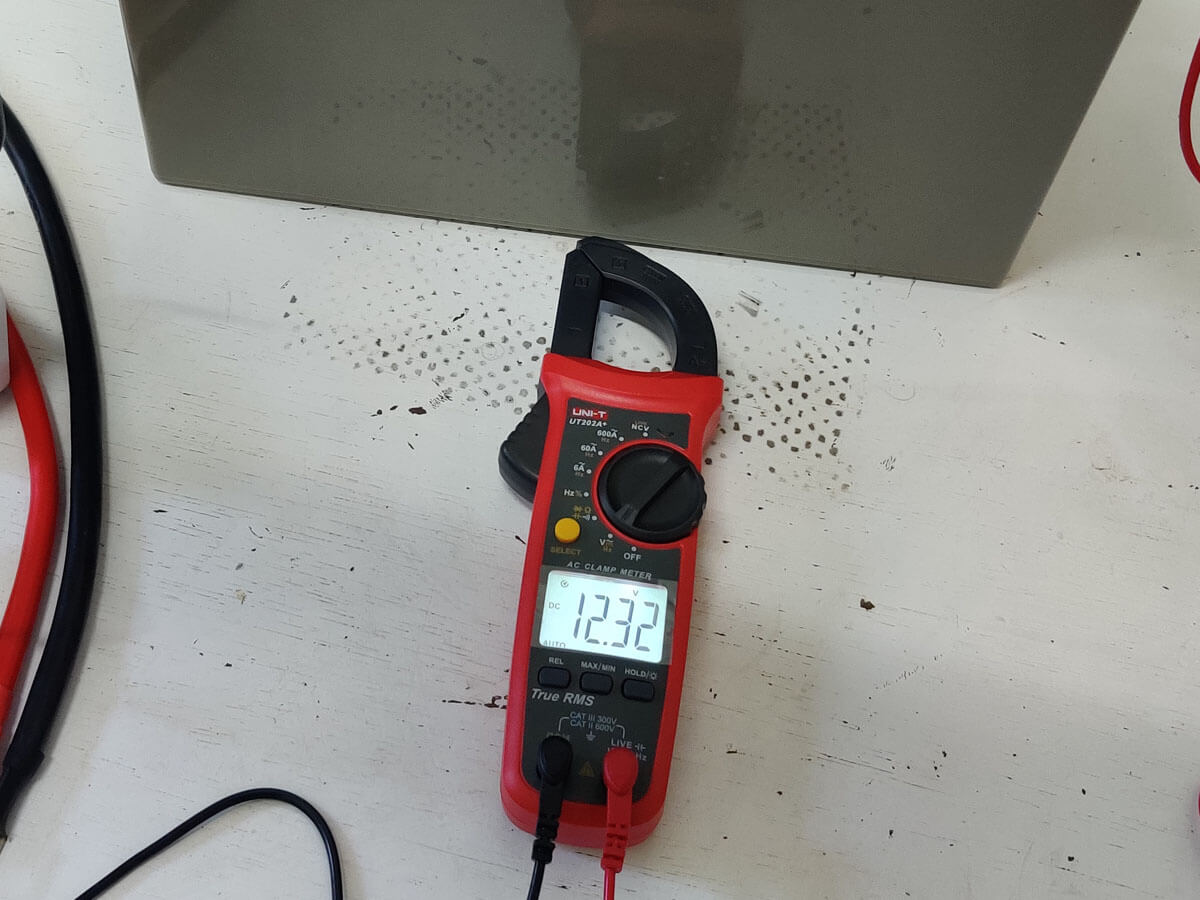 Now, If I had used a lithium battery instead, I wouldn’t have needed to worry about its state of charge and could have kept the refrigerator running until the battery was fully discharged.
In theory, this would have allowed me to run the fridge for approximately 13 to 14 hours on a single charge using a 12V 100Ah lithium battery.
Now, If I had used a lithium battery instead, I wouldn’t have needed to worry about its state of charge and could have kept the refrigerator running until the battery was fully discharged.
In theory, this would have allowed me to run the fridge for approximately 13 to 14 hours on a single charge using a 12V 100Ah lithium battery.
12V-100Ah Lithium Batteries
How long will a battery run your refrigerator?
As I mentioned earlier, how long your fridge runs on a battery depends on two things:- How much energy your fridge uses.
- How much energy your battery can provide on a single charge, a.k.a its Usable Capacity.
The Usable Capacity of your battery:
A battery typically has two key ratings:- Its “Voltage” rating, measured in “Volts” or “V”.
- Its “Charge Capacity” rating, measured in “Amp-hours” or “Ah”.
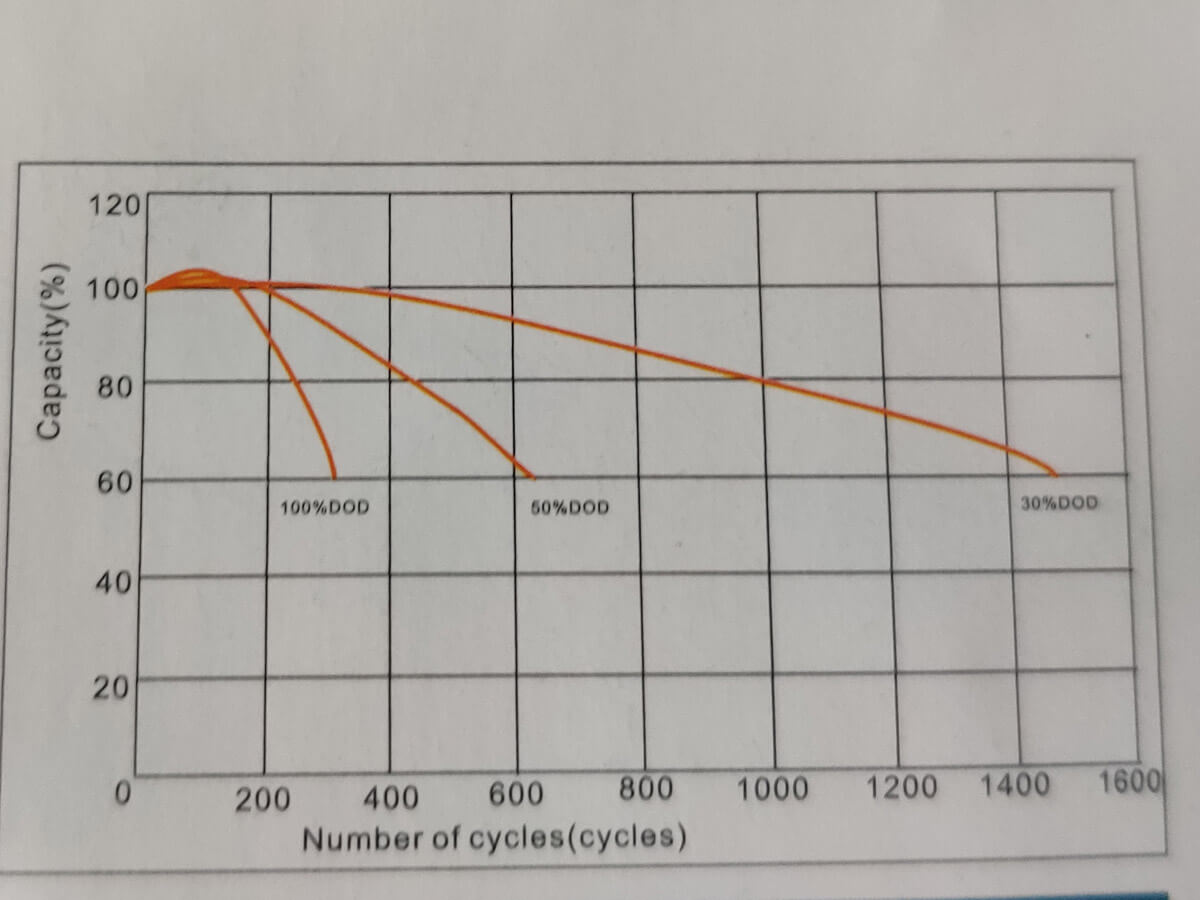
12V-100Ah Lithium Batteries
| Battery Chemistry | Recommended Depth of Discharge (DoD) | Usable Battery Capacity (Wh) | |
| 12V-50Ah | 12V-100Ah | ||
| FLA (Flood Lead-Acid) | 30% – 50% | 180 – 300 Wh | 360 – 600 Wh |
| SLA (Sealed Lead-Acid) | 30% – 50% | 180 – 300 Wh | 360 – 600 Wh |
| AGM (Absorbed Glass Matt) | 30% – 50% | 180 – 300 Wh | 360 – 600 Wh |
| Li-Ion (Lithium Ion) | 80% – 100% | 480 – 600 Wh | 960 – 1200 Wh |
| LiFePO4 (Lithium Iron Phosphate) | 80% – 100% | 480 – 600 Wh | 960 – 1200 Wh |
The Energy Consumption of your fridge:
There are a few ways to determine the energy usage of your refrigerator, the most accurate of which is to measure it like I did, using an electricity monitoring device such as the Kill-A-Watt. Here’s a quick video I made documenting this: Related: Appliance Energy Consumption Calculator Since I had already measured my fridge’s energy usage and found it to be around 100 Wh per hour, estimating the runtime was straightforward. I simply divided the usable capacity of my battery by this measurement: Runtime (hours) = Usable Battery Capacity (Watt-hours) ÷ Refrigerator’s Hourly Energy Consumption (Watt-hours/hour) Runtime (hours) = 600 Wh ÷ 100 Wh/hour Runtime (hours) = 6 hours As seen before, this estimate is pretty close to the actual results of my test. If you don’t have an electricity monitor, you can still estimate your fridge’s energy usage using its electrical ratings. You can do this with a simple rule of thumb: Hourly Energy Consumption (Watt-hours) = Wattage Rating (Watts) x 0.5 hours And if the wattage of your fridge isn’t provided, you can calculate it using the voltage (Volts) and current (Amps) ratings: Wattage (Watts) = Voltage (Volts) x Amperage (Amps) For example, as you can see in the image below, my refrigerator has a Rated Voltage of 240 Volts and a Rated Current of 1 Amp: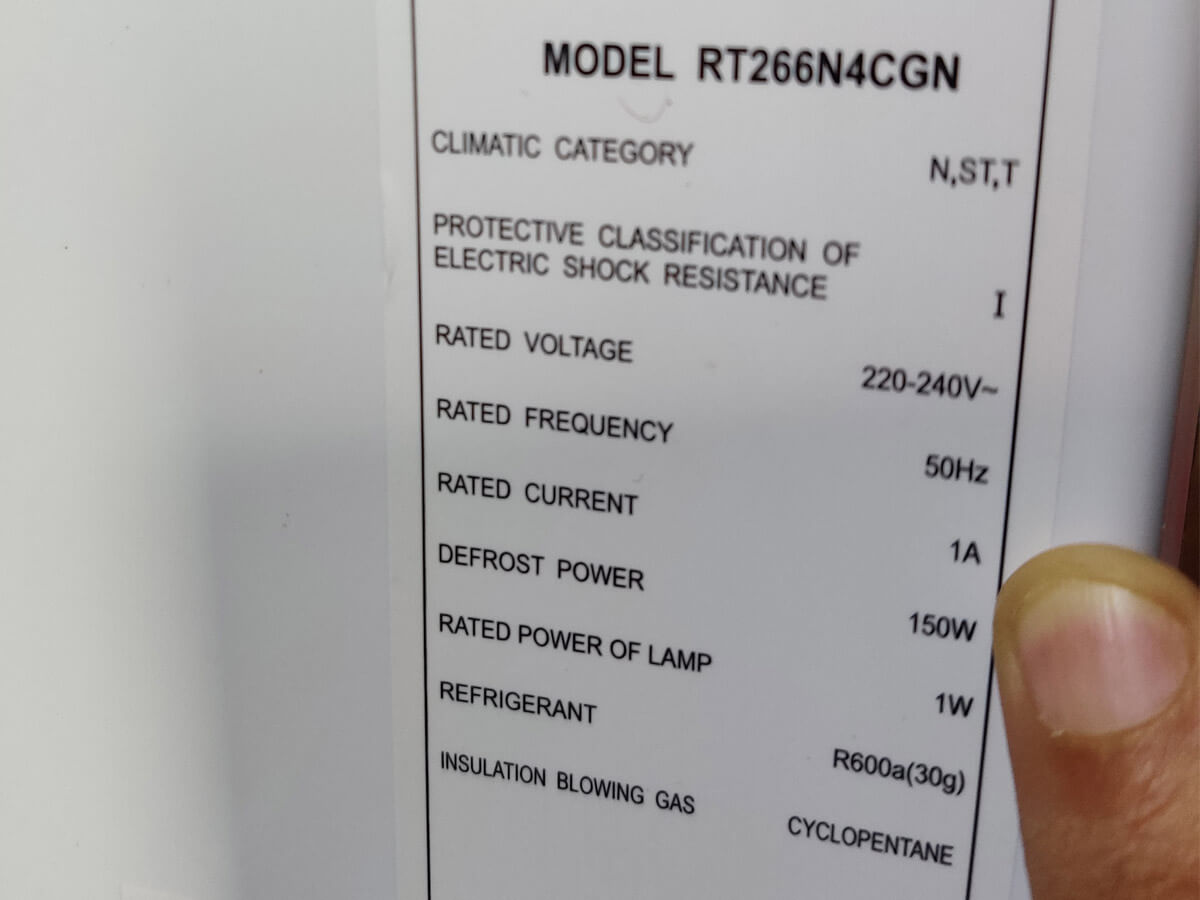 Using these ratings, I can calculate the Wattage of my fridge as follows:
Wattage (Watts) = Voltage (Volts) x Amperage (Amps)
Wattage (Watts) = 240 Volts x 1 Amp
Wattage (Watts) = 240 Watts
And, using the Wattage of the fridge, I can estimate its hourly energy use:
Hourly Energy Consumption (Watt-hours) = Wattage Rating (Watts) x 0.5 hours
Hourly Energy Consumption (Watt-hours) = 240 Watts x 0.5 hours
Hourly Energy Consumption (Watt-hours) = 120 Watt-hours
Although this estimate is around 20% higher than my fridge’s actual energy consumption (100 Wh), it still provides a fairly accurate idea of what to anticipate.
In any case, if you would like your refrigerator to run longer on the battery, you can always expand your battery bank to reach the desired runtime, and you can calculate what size battery to run the fridge using the following formula:
Battery Size (Watt-hours) = Refrigerator’s Energy Usage for the Desired Runtime (Watt-hours) ÷ DOD of the Battery (%)
For example:
According to the manufacturer, this Dometic 12V fridge consumes 18 Wh/h (18 Watt-hours per hour) on average.
As an example, let’s say I’m going camping for 5 days (120 hours) and I’m going to use Lithium batteries to power this fridge during my trip. This is the amount of energy that the 12V cooler will consume during this period:
5 days’ energy consumption (Watt-hours) = 18 Wh/hour x 120 hours
5 days’ energy consumption (Watt-hours) = 2160 Wh
Since I’m going to use a Lithium battery bank, I will have access to 100% of the battery’s capacity:
Battery Size (Watt-hours) = Refrigerator’s Energy Usage for the Desired Runtime (Watt-hours) ÷ DOD of the Battery (%)
Battery Size (Watt-hours) = 2160 Wh ÷ 100%
Battery Size (Watt-hours) = 2160 Wh ÷ 1
Battery Size (Watt-hours) = 2160 Watt-hours
For this scenario, a suitable option would be the 12V 200Ah Li Time battery, which can supply up to 2400 Wh (12V x 200Ah) of energy on a single charge.
Another option would be to use 2 of these 12V 100Ah Li-Time batteries and wire them in parallel to make up a 12V 200Ah battery bank.
However, an even more practical and much cheaper option to get longer runtimes would be to run the refrigerator on solar power.
Since solar panels are cheaper than batteries, it would make more sense to use a combination of solar and batteries rather than just batteries, especially if you’re planning long camping trips or need energy backup for a larger refrigerator that consumes a lot of energy.
If the solar system is properly sized, all you’d need is enough battery backup for one day’s worth of your refrigerator’s energy usage, and the solar panels would produce enough energy every day to keep the battery bank charged.
You can check out my article on how many solar panels you need to run a refrigerator for a step-by-step guide on this.
Using these ratings, I can calculate the Wattage of my fridge as follows:
Wattage (Watts) = Voltage (Volts) x Amperage (Amps)
Wattage (Watts) = 240 Volts x 1 Amp
Wattage (Watts) = 240 Watts
And, using the Wattage of the fridge, I can estimate its hourly energy use:
Hourly Energy Consumption (Watt-hours) = Wattage Rating (Watts) x 0.5 hours
Hourly Energy Consumption (Watt-hours) = 240 Watts x 0.5 hours
Hourly Energy Consumption (Watt-hours) = 120 Watt-hours
Although this estimate is around 20% higher than my fridge’s actual energy consumption (100 Wh), it still provides a fairly accurate idea of what to anticipate.
In any case, if you would like your refrigerator to run longer on the battery, you can always expand your battery bank to reach the desired runtime, and you can calculate what size battery to run the fridge using the following formula:
Battery Size (Watt-hours) = Refrigerator’s Energy Usage for the Desired Runtime (Watt-hours) ÷ DOD of the Battery (%)
For example:
According to the manufacturer, this Dometic 12V fridge consumes 18 Wh/h (18 Watt-hours per hour) on average.
As an example, let’s say I’m going camping for 5 days (120 hours) and I’m going to use Lithium batteries to power this fridge during my trip. This is the amount of energy that the 12V cooler will consume during this period:
5 days’ energy consumption (Watt-hours) = 18 Wh/hour x 120 hours
5 days’ energy consumption (Watt-hours) = 2160 Wh
Since I’m going to use a Lithium battery bank, I will have access to 100% of the battery’s capacity:
Battery Size (Watt-hours) = Refrigerator’s Energy Usage for the Desired Runtime (Watt-hours) ÷ DOD of the Battery (%)
Battery Size (Watt-hours) = 2160 Wh ÷ 100%
Battery Size (Watt-hours) = 2160 Wh ÷ 1
Battery Size (Watt-hours) = 2160 Watt-hours
For this scenario, a suitable option would be the 12V 200Ah Li Time battery, which can supply up to 2400 Wh (12V x 200Ah) of energy on a single charge.
Another option would be to use 2 of these 12V 100Ah Li-Time batteries and wire them in parallel to make up a 12V 200Ah battery bank.
However, an even more practical and much cheaper option to get longer runtimes would be to run the refrigerator on solar power.
Since solar panels are cheaper than batteries, it would make more sense to use a combination of solar and batteries rather than just batteries, especially if you’re planning long camping trips or need energy backup for a larger refrigerator that consumes a lot of energy.
If the solar system is properly sized, all you’d need is enough battery backup for one day’s worth of your refrigerator’s energy usage, and the solar panels would produce enough energy every day to keep the battery bank charged.
You can check out my article on how many solar panels you need to run a refrigerator for a step-by-step guide on this.Spread knowledge... It's FREE!!


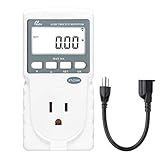











Thank you for your www. I think it’s achieving your aim. Info here is digestible.
Thank you for a very well explained article on the use of refrigerators for away from home trips. You seem to suggest (and are almost certainly correct), that all refrigerators are much of a muchness. I guess however that there must be a number that, due to insulation, internal volume, quality of manufacture, method of opening (top or side), etc., consume marginally less electricity than others. If there was one that you consider to be the best in this respect, which one would it be.
Regard
Peter Wright
Thanks for the info. I am sizing components for my auxiliary battery system in my truck.
Regarding the Dometic Cooler, looks like it consumes 1.02A at 120v AC and 10.4 A at 12v DC.